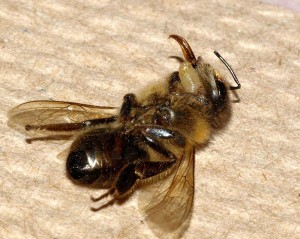Call San Bernardino Local Bee Company! Bee Removal & Wasp Control Service. Same Day Live Removals. · Phone Quotes · Wasp and Hornet Removal. Open 24/7 Same Day Service Call us: 951-476-8495
Enjoy our new article:
Tracking a Parasite That Turns Bees Into Zombies
Call it “The Buzzing Dead.” Infestations of what scientists have dubbed “zombie bees” have spread across both the West and East coasts in recent years.
The honeybee hordes, while not actually undead, are the unwilling hosts to a parasite infection that researchers think drives the drones to act erratically, or “zombielike,” in the moments before they die.
To better understand the parasitized swarms, John Hafernik, an entomologist at San Francisco State University has recruited people countrywide to join his hunt.
“The big question for us was, ‘Is this a San Francisco thing?’ Or something that is taking place all over the country that has not been noticed by biologists before,” he said.
Since he began the project four years ago, he has concluded the answer is the latter. Volunteers have helped identify infected honeybees in California, Washington and Oregon as well as Vermont, Pennsylvania and New York. More than 800 bee observations have been uploaded to the ZomBee Watch online database.
Dr. Hafernik first discovered something eerie was happening to the bees on his campus in 2008 when he stumbled upon several of them staggering in circles along the sidewalk. For weeks he picked a few up and placed them in a glass vial with plans to feed them to his pet praying mantis.
One day he came across a vial he had forgotten on his desk for a couple of weeks. The bees inside were dead, but the vial was overwhelmed with small brown fly pupae. He came to the realization that the bees were parasitized.
After further exploration across San Francisco Bay, he and his colleagues found several bees that were also behaving strangely. They would fly from their hives at night, which was something bees would normally never do, and then circle around a light fixture. After their nocturnal dance the bees would drop to the ground and start walking strangely. They were succumbing to their overlord, larvae of the fly Apocephalus borealis.
The life cycle of the parasitic fly is straight from a horror story. The female fly uses something called an ovipositor, which is like a hypodermic needle, to inject her eggs into the abdomen of the honeybee.
About a week later the larvae lurking within the abdomen wriggle into the bee’s thorax and start liquefying and devouring its wing muscles. Then, like in the movie “Alien,” they burst through the bee’s body, erupting from the soft space between its head and shoulder area.
“As far as we know this is a death sentence,” Dr. Hafernik said. “We don’t know any bees that have survived being parasitized by these maggots.”
As many as 80 percent of the hives that Dr. Hafernik examined in San Francisco Bay had been infected. Understanding more about how the infection spreads is important, he said, because although the infestations are not the main driver behind honeybee declines across the country, they could help collapse an already vulnerable colony.
Need a Quote? you will get a response in few minutes.
[wpseo_address id=”792″ show_state=”1″ show_country=”1″ show_phone=”1″ show_phone_2=”1″ show_fax=”1″ show_email=”1″ show_logo=”0″]


